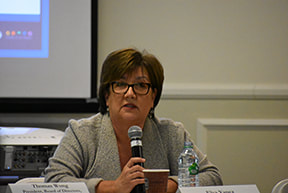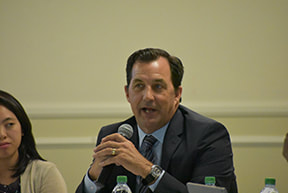
BY DEVIKA C. MEHTA
LOS ANGELES, CA - California experienced the worst drought from 2012 to 2016. The situation was a little better in 2017, but experts warn that more droughts are likely to hit the state in coming years. To analyze the dire situation and combat drastic weather conditions in LA County, on March 9, a roundtable community media briefing and...
LOS ANGELES, CA - California experienced the worst drought from 2012 to 2016. The situation was a little better in 2017, but experts warn that more droughts are likely to hit the state in coming years. To analyze the dire situation and combat drastic weather conditions in LA County, on March 9, a roundtable community media briefing and...
Q&A session was organized by Sandy Close, Executive Director, Ethnic Media Services at the Japanese American Cultural Center, here. During an hour-long panel session, several prominent scientific heads came together to discuss the crucial topic- “Capturing LA’s ‘Liquid Gold: The County’s Bold Plan for Storm Water”.
Introducing guests and welcoming media members was Close, who requested the community to explore the county’s Safe, Clean Water for LA Program. Joining her were other members who debated potential funding measures which could support multi-benefit storm water projects in LA County’s diverse communities.
LA County Supervisor Hilda Solis addressing the gathering said, “Last fall, a single storm dropped more than 2.5 inches of rain on Los Angeles, 10 times the amount of precipitation we usually get at that time of year. All that water, coming down at once, went to waste. It didn’t help our tree canopy, replenish groundwater aquifers or reduce our dependence on imported water. Instead, the downpour caused flooding with most of the water flowing directly into the ocean, taking with it tons of trash, oil and other pollutants. We never know when those storms will arrive, but we must be prepared when they do.”
“When we experience heavy rains, our existing system captures only a fraction of rainfall: LA County lost over 107 billion gallons of water during last year’s storms – enough to meet the needs of more than 2.5 million people for an entire year,” she concluded. Other speakers brought up various issues. JR DeShazo, Chair of the Department of Public Policy, Luskin School of Public Affairs, UCLA discussed how investments in storm water infrastructure could drastically enhance local water resources and improve public health.
“During an average Los Angeles County storm, 10 billion gallons of usable water literally goes down the drain and straight to the ocean, so let’s try to improve our ability to capture rainfall when it does rain. ”
Mark Pestrella, Director, LA County Department of Public Works talked on how severe the aspect of climate change is and what the county should do to turn it into ‘Liquid Gold’, saying, “Unfortunately, we are unable to use the rains often referred to as storm water, instead it hits city streets and sidewalks, then flows into storm drains carrying with it trash, oil and everything else on the streets, and ultimately flows into the Pacific Ocean thus creating environmental and public health impacts from polluted runoff.”
Elva Yanez, Director of Health Equity, Prevention Institute pointed, “Our community and region desperately need this locally produced water. We know we need to be prepared for when it does rain. What’s missing is the public’s awareness of the issue and the political will to solve it. Both will be addressed in 2018.”
Alina Bokde, Deputy Director, Planning and Development, LA County Dept. of Parks and Recreation and Roxana Tynan, Executive Director, LA Alliance, talked about building a multi-use storm water infrastructure.
“We need to build projects that not only capture storm water and dry-weather runoff, but also clean and use this scarce resource and prevent polluted runoff from poisoning our groundwater, rivers and beaches. The end result will be more green space in park-deficient cities, leading to healthier communities and creating good-paying green jobs at the same time,” they agreed. Other speakers who also took keen interest in the issue were Ariane Jong, Staff Scientist, Council for Watershed Health and Thomas Wong, President, Board of Directors, San Gabriel Valley Municipal Water District Board. They gave some very interesting ideas to preserve near and long-term future of California The discussion ended with a Q&A session and light lunch.
Introducing guests and welcoming media members was Close, who requested the community to explore the county’s Safe, Clean Water for LA Program. Joining her were other members who debated potential funding measures which could support multi-benefit storm water projects in LA County’s diverse communities.
LA County Supervisor Hilda Solis addressing the gathering said, “Last fall, a single storm dropped more than 2.5 inches of rain on Los Angeles, 10 times the amount of precipitation we usually get at that time of year. All that water, coming down at once, went to waste. It didn’t help our tree canopy, replenish groundwater aquifers or reduce our dependence on imported water. Instead, the downpour caused flooding with most of the water flowing directly into the ocean, taking with it tons of trash, oil and other pollutants. We never know when those storms will arrive, but we must be prepared when they do.”
“When we experience heavy rains, our existing system captures only a fraction of rainfall: LA County lost over 107 billion gallons of water during last year’s storms – enough to meet the needs of more than 2.5 million people for an entire year,” she concluded. Other speakers brought up various issues. JR DeShazo, Chair of the Department of Public Policy, Luskin School of Public Affairs, UCLA discussed how investments in storm water infrastructure could drastically enhance local water resources and improve public health.
“During an average Los Angeles County storm, 10 billion gallons of usable water literally goes down the drain and straight to the ocean, so let’s try to improve our ability to capture rainfall when it does rain. ”
Mark Pestrella, Director, LA County Department of Public Works talked on how severe the aspect of climate change is and what the county should do to turn it into ‘Liquid Gold’, saying, “Unfortunately, we are unable to use the rains often referred to as storm water, instead it hits city streets and sidewalks, then flows into storm drains carrying with it trash, oil and everything else on the streets, and ultimately flows into the Pacific Ocean thus creating environmental and public health impacts from polluted runoff.”
Elva Yanez, Director of Health Equity, Prevention Institute pointed, “Our community and region desperately need this locally produced water. We know we need to be prepared for when it does rain. What’s missing is the public’s awareness of the issue and the political will to solve it. Both will be addressed in 2018.”
Alina Bokde, Deputy Director, Planning and Development, LA County Dept. of Parks and Recreation and Roxana Tynan, Executive Director, LA Alliance, talked about building a multi-use storm water infrastructure.
“We need to build projects that not only capture storm water and dry-weather runoff, but also clean and use this scarce resource and prevent polluted runoff from poisoning our groundwater, rivers and beaches. The end result will be more green space in park-deficient cities, leading to healthier communities and creating good-paying green jobs at the same time,” they agreed. Other speakers who also took keen interest in the issue were Ariane Jong, Staff Scientist, Council for Watershed Health and Thomas Wong, President, Board of Directors, San Gabriel Valley Municipal Water District Board. They gave some very interesting ideas to preserve near and long-term future of California The discussion ended with a Q&A session and light lunch.







 RSS Feed
RSS Feed
